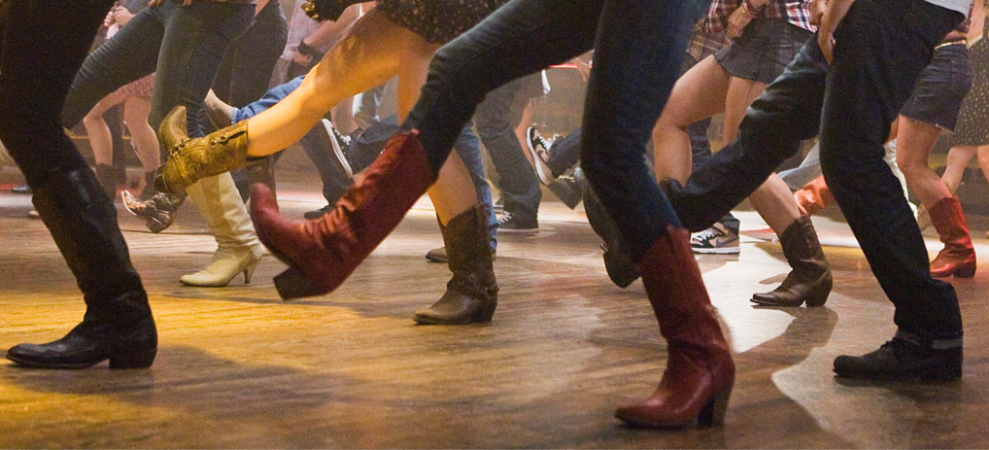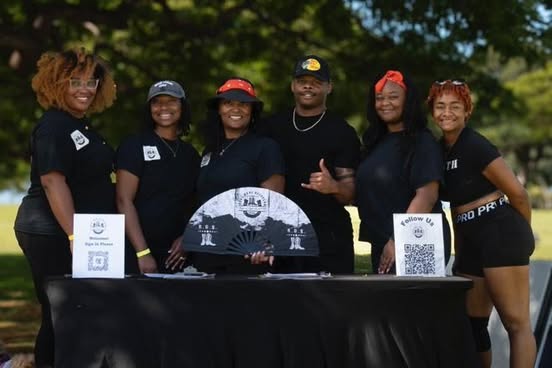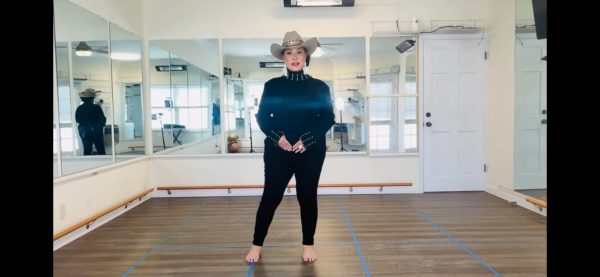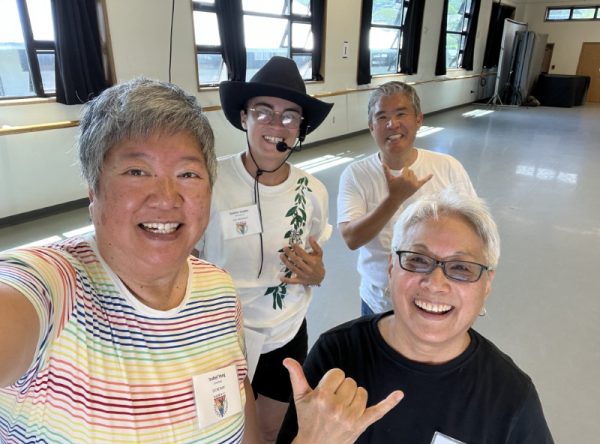
Most people know Hawaiʻi for its hiking trails, food culture, and world-famous surf scene. But there’s another community quietly growing in popularity among both locals and tourists on the islands. Numerous clubs, organizations, and groups have been drawn into line dancing as it creates space for different cultures and identities to come together, allowing people to express their most authentic selves.
Traditionally, line dancing involves people standing side by side in lines, performing synchronized steps—often a series of four counts—swaying left or right with stylish turns or hip movements. The music can be upbeat and rowdy with a twang, or soft and mellow, like a leaf drifting in the breeze. Line dancing took off during the 1970s disco era, coinciding with the rise of country line dancing as a popular daytime social activity. Five decades later, it is connecting diverse cultures and fostering community—especially here in Hawaiʻi.
Real Deal Steppers – Bringing Southern Soul to Oʻahu
Real Deal Steppers was founded by Alvin Conley, originally from South Louisiana, and Denise Smith, from Virginia. Like many who come to the islands through military service, they’ve had their fair share of loneliness, from leaving everything familiar behind to anxiety about integrating into a new culture.
Smith is married to an active-duty sailor. “This is my second time here, so, honestly, I was not looking forward to (the move). Knowing the distance and knowing that my children are older, this time around,” she said. After meeting in a Facebook group, Smith, Conley, and four others formed the Real Deal Steppers. The club began with just six members and has since grown to around 40 participants. They hold line dancing practices every other week in Wahiawa, Pearl City, and Honolulu, welcoming dancers of all levels. Smith explained that southern line dancing is similar to square dancing, but with an infusion of R&B, soul and rap.

Compared to traditional country line dancing, southern line dancing features a smoother, more rhythmic style where musicality, personal expression, and individual flair take center stage. Dancers often wear flashy or streetwear-inspired outfits—think sneakers, heels, bold prints, or accessories like fans. In contrast, country line dancers typically embrace a cowboy aesthetic, with boots, jeans, and cowboy hats. The movements in southern line dancing are more expressive, often incorporating facial expressions, body rolls, and stylish sways—even using props like fans to enhance the performance.
Country line dancing tends to stick to simpler, more upright movements, focused on footwork and uniformity. Even the venues reflect these cultural differences: southern line dancing is often seen at community events, family gatherings, and social clubs, while country line dancing is more commonly found in country bars and honky-tonks—traditional southern dance halls. While the two styles may occasionally overlap, especially depending on the song, southern line dancing stands out for its soulful rhythm and vibrant personality.
“We’re all in sync, you know, the more people you have, the better it looks, like the Janet Jackson Rhythm Nation video,” Smith said. “It just radiates, and it puts smiles on people’s faces because once you see one person doing it, then it’s just kind of like wavelengths.”
“I’d had no previous line dance experience outside of, like, the cupid shuffle. So much so that my nickname in the group is two left feet. But yeah, they try to teach me as best as possible, and it’s coming along well,” Conley said
Conley’s primary motivation for creating the club wasn’t just to build a sense of community for Black people—or even to focus solely on line dancing, though that’s definitely a fun part of it. His deeper intention was to foster cultural exchange, inclusion, and connection among the diverse communities of Hawai‘i. From Kānaka Maoli (Native Hawaiians of Polynesian descent) and local residents, to tourists and members of the military, the club became a space to celebrate each person’s unique flair while honoring the richness of everyone’s background—all within the framework of a proudly Black-owned space.
“One of the first things I noticed when I came to Oʻahu was how warm and welcoming the Native Hawaiians and local residents were. They’re incredibly family-oriented,” Conley said. He added that he deeply respects their values and the way they treat the community like family. “With the Real Deal Steppers, we aim to carry those same values—showing respect while also staying open and inclusive.”
Īlaniwai Waimea – Line Dancing with Traditional Hula
When people think of hula, they don’t usually consider it a form of line dancing—even though it often features dancers moving in lines and performing synchronized steps. Since line dancing is typically seen as a Western style, the two are rarely connected. However, Natalie Ai Kamauu has found a way to blend the two worlds, creating a unique fusion of tradition and innovation at Īlaniwai Waimea, where she teaches.
“Hula is the way I think. I’m not good at math, but hula only deals with four counts—four to the right, four to the left, four forward, four backward. I’m so good at fours,” Kamauu said with a laugh. “I can be walking down the aisle at Safeway, and a song will come on and just—the body naturally moves. And instead of shopping, there I am, dancing hula down the aisles.”
Kamauu, deeply rooted in hula and her hometown of Waimea, has merged traditional Hawaiian dance with the country and line dancing culture that surrounds her. The result is a style that honors ancestral storytelling while embracing contemporary forms of movement and community.
“When I did this line dance, and I taught it to our students, I said to them, when we do hula steps, they have to be beautifully done and correctly done,” Kamauu said. “That’s the only way that this can be accepted—if our hula is good, then we can play with each other.”
Hula, a sacred and deeply cultural dance form practiced by Kānaka Maoli, has long served as a way to share ancestral knowledge, stories, and values. Kamauu describes hula as a series of foundational steps passed down through generations of her family.
“Hula’s in my life, but hula was also in my mom’s life. Hula was in my grandma’s life. Hula was in my great-grandma’s life, and in my great-great-grandma’s life. And that’s where I know it stops,” she said.

One of the most basic and essential steps in hula is the Kāholo—a four-step movement to the right, then to the left—done with bent knees and a gentle sway of the hips. Other core steps include the ‘Ami, a circular hip rotation that mimics the tide of the ocean; the ‘Uwehe, a sharp lifting of the heels that opens the knees outward, often interpreted as a branch breaking in the wind; and the Ku‘i, a strong, grounded step paired with a kick to emphasize power and punctuation. The Kalākaua step, which moves forward with bent knees and a sway to the right before returning left, symbolizes both progression and return.
Kamauu compares the movements of hula to imitations of nature. The swaying hips represent flowers blowing in the wind, the ‘Ami mirrors ocean tides, and the hands—considered the second-most important part of the dance—act as an extension of the body’s storytelling.
“They’re just like the color—the color of the hula,” she said. “We bend our knees, we connect to the land. We believe that the land is what feeds us, not just our food, but our energy. And so when we place our feet into the ground before we dance, we’re waiting for, and desiring, that connection back to the land—from where we come, and to where we’ll return. Within hula are the histories and the stories of our land, of our people. We dance stories of places that don’t exist anymore. We dance of birds that don’t exist anymore.”
Though hula and Western line dancing come from very different cultural backgrounds, Kamauu sees their connection in the shared rhythm, structure, and sense of community. Both rely on choreographed, synchronized movement performed in lines, often to a consistent beat that guides the body through space. Just as hula reflects the elements of nature through stylized motion, Western line dancing incorporates stomps, sways, and turns to match the emotional tone of country or soul music.
In her classes Kamauu emphasizes that while dancing is joyful, hula requires full dedication—physically and mentally.“The classes are an hour long, and I push a positive attitude in every class. But I tell my students: each movement has to be precise and intentional,” she said. “It’s not easy. Hula is hard on the body and the mind, and it takes 100 percent every time.”
Many people watching hula are unaware of the physical effort involved—and how demanding it can be on the body. “I don’t know if anybody realizes that it actually hurts to keep your knees bent while dancing hula,” Kamauu said. “We all have strong thighs because we have to hold that bend. And our hips are well-developed because we’re constantly engaging those muscles. It’s not just from eating poi—it’s a full-body workout.”
By blending the storytelling of hula with the rhythmic structure of line dancing, Kamauu is expanding what dance can be—honoring her cultural roots while creating space for growth, joy, and shared movement in her Waimea community
.
Blazing Saddles Hawaiʻi: Promoting LGBTQ+ Inclusivity Through Line Dancing
Blazing Saddles Hawaiʻi (HI) has built a vibrant line dancing community that also embraces and unifies LGBTQ+ identities. The country dance club was established in 1990, with a mission to provide a comfortable, non-judgmental, nurturing, supportive, and safe environment where people can dance, socialize, and have fun.
Their goal is to promote the culture of country-western dancing and offer education in dance, activities, and music to all individuals—regardless of age, sex, gender identity, religion, national or cultural origin, sexual orientation, disability, or HIV status.
Robbie Snyder, Vice President of Blazing Saddles Hawaiʻi, who uses they/them pronouns, says they’ve never ever thought about attempting to do line dancing on the mainland. They moved to the islands in 2019, and while browsing for social groups, came across Blazing Saddles.
“I saw that it was gay, and I was like, oh my God, I’m so there,” Snyder said.

When Snyder first arrived, they came to Blazing Saddles alone. But after a few visits, they quickly found that the members were more than just dance partners — they were like family, offering rides and support. Snyder kept coming back, and over time, the group became an even closer-knit community, sharing dances, practicing together, and enjoying potluck dinners.
“It has such a family feel—everyone is clearly accepting and supportive. They don’t care how good or bad you are at dancing; they’ll tell you, ‘You’re not bad, you’re just a beginner.’ It’s a really warm and encouraging environment, and that’s what kept me coming back,” Snyder said.
Blazing Saddles HI teaches line dancing every Tuesday (except for the second Tuesday of the month) at the Ala Wai golf course, starting around 6:30 p.m. The lesson typically lasts about half an hour, depending on the difficulty of the dance. After the lesson, everyone has the chance to dance through it together. Later in the evening, usually around 8 p.m., there’s a review of a different dance—often one taught the previous week or a few weeks prior—to help everyone remember and practice.
Isabella Yang, who serves on the board of directors at Blazing Saddles HI, says she and her wife Dawn have been attending since 2002. She admits she wasn’t interested in line dancing until taking a class at Blazing Saddles HI. What really stood out to her was the crowd—it tended to be an older demographic than at other social gatherings.
“I like the mix, because our members range anywhere from people in their 20s all the way into their 80s. So our oldest members are in their 80s, and I think most of the people are probably 50, 60, 70, so we attract everything. We’re all in this big group and so everyone dances, everyone teaches each other, and then we just have a good time,” Yang said.
For many in the LGBTQ+ community, especially older queer women, finding nightlife or social spaces where they feel fully safe and seen can still be a challenge. But that’s what makes spaces like Blazing Saddles HI so vital. As a queer-centered line dancing event, it provides not just music and movement, but a sense of belonging—for people who might otherwise feel the need to shrink or hide parts of themselves. It’s not just about dancing in sync; it’s about being able to show up fully, without fear of judgment or harm.
Line dancing holds different meanings for those who take part in it. For some, it offers a sense of home—a space to connect, share, and move in unison with others. For others, it’s a way of life, a celebration of culture and heritage passed down through generations. It can serve as a bridge between honoring traditional values and embracing the contemporary rhythms and styles that reflect today’s evolving world.